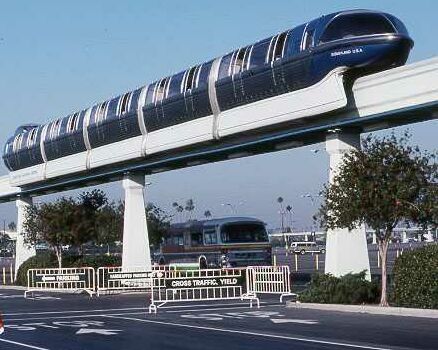
Light Rail Now/Light Rail Progress can be contacted at: Light Rail Now! |
Dave Dobbs is executive director of the Texas Association for Public Transportation, and publisher of the Light Rail Now! website. What is an appropriate role for monorail systems? Monorail as public transit tends to have its place particularly where nothing else fits and there is a need to connect at least two points of high activity. North American cities continue to evaluate monorail for possible future transit links where space is tight, some form of elevated, automated guideway is suitable, and other factors exist where monorail may have an advantage.
In the U.S.A., monorail technology is being aggressively pushed by monorail enthusiasts as an alternative to light rail transit (LRT). However, most of the claims that monorail is cheaper to build, is cheaper to operate (will "make a profit"), is better suited to the urban environment, etc., are unsubstantiated or not supported by the actual data available from existing monorail operations when compared to LRT systems currently in operation. For example, the actual total cost to install a mile of monorail in Las Vegas right now (based on actual project costs) is approximately $141 million a mile – more than four times the price per mile what it has cost so far to build the existing (and rapidly expanding) 45-mile Dallas light rail system, and more than three times what light rail is projected to cost per mile for new-start LRT projects such as the one now underway in Charlotte, NC. (See the articles Monorail Capital Costs: Reality Check and More on Monorail Costs: Federal New Starts Data Show Surface LRT Has 1/3 Cost of Monorail on this website.) The claims that monorail will make a profit (not require a subsidy) are based on the Japanese experience. But this is an environment where many urban rail systems (light rail, streetcars. metro rail, commuter rail, intercity rail) make an operating "profit" (surplus) in a market that is extremely difficult to duplicate in the U.S. (See the article Japanese Transit Profitability – No Monopoly for Monorails on this website.) I have been told by advocates that no deaths have ever been recorded on American monorails, but consider that the dozen that exist here altogether have less combined mileage (32.8 miles of monorail in all of North America) than each of the following individual cities have light rail miles: Dallas (45.0), Los Angeles (41.8). Philadelphia (34.2), Portland (33.1), St. Louis (42.8), San Diego (more than 50), and Toronto (46.9). Monorails represent just a tiny fraction of total standard rail mileage – limiting accident exposure.
On a daily basis, more than one million individuals use U.S. light rail systems. in contrast, only about 8,400 ride the two monorails currently operating in urban revenue service. (See the Light Rail Now! article Over 5 Million People Use America's Rail and Other "Guideway" Systems Daily.) That's about 119 people using urban light rail for every person using an urban monorail in America. Factor in the much shorter trip lengths of these riders, convert that to total passenger-miles (so far, comparatively minuscule for monorail), and it begins to become apparent why monorail accidents, in the universe of urban public transit, are virtually off the radar screen.
In Canada, Toronto, Edmonton, and Calgary operate modern LRT systems. LRT is being pursued in Waterloo-Kitchener, Ontario, and is under study for Montreal and Quebec City. Monorail, in contrast – despite an almost fanatical campaign by monorail proponents – is seeing extremely limited North American development. Only Seattle and Las Vegas have active, funded monorail projects underway, and a tiny handful of cities, such as Wilmington, De and St. Petersburg, Fl, are seriously evaluating possible urban monorails for their core fixed-guideway systems. Seattle, of course, already has been operating a short (0.9-mile) monorail shuttle for about 40 years (now considered a venerable landmark), and Jacksonville has been operating another short (2.5-mile) monorail circulator in its CBD. The relatively high cost of monorail construction has undoubtedly been a factor limiting the size of these operating systems. Rather than some hi-tech modern transit cure-all, the monorail concept – as William D. Middleton's Metropolitan Railways: Rapid Transit in America reveals – predates electric street railways, the predecessor of light rail, by at least ten years. The fact that streetcars, light rail, interurbans, and other conventional forms of dual-rail urban transit (subways, elevateds, etc.) proliferated everywhere in the world beginning in the late nineteenth century to the present day, while monorail systems remain few and far between, says a great deal about the relative versatility, suitability, reliability, and cost-effectiveness of traditional dual steel-rail technology.
Light Rail Now! website Updated 2004/02/06 |
|
|
|